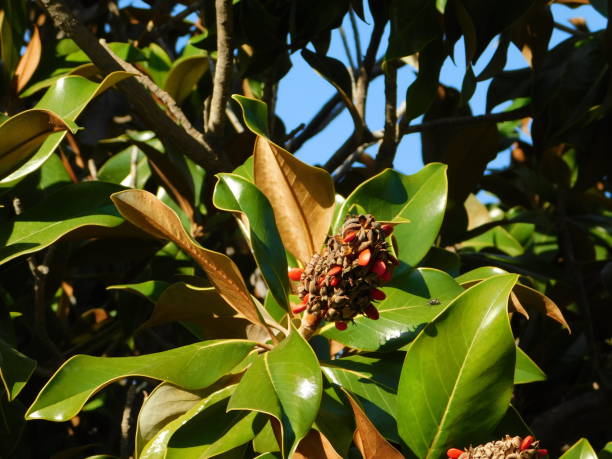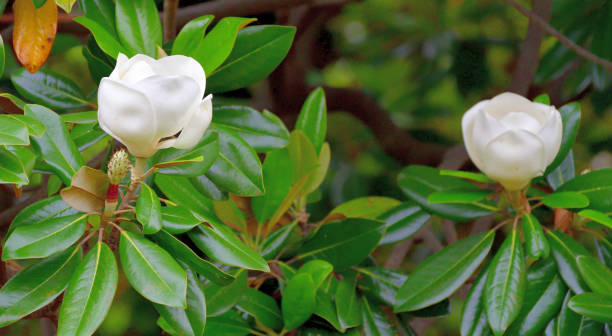How To Grow Magnolia From Seed
Magnolias are popular trees prized for the beautiful, large, and showy flowers they produce during the spring season. It is a popular flowering plant. New varieties of magnolias are being introduced all the time, but how do you grow your own from seeds? This guide will show you how if you want to grow magnolias from seed. You will also learn some basics of growing magnolias from seed, including the best time to do so and important things that need to be taken care of during the process.
Table of Contents
Steps in Growing Magnolia From Seeds

Step 1-Collecting Magnolia Seeds
You can collect the magnolia seed pods from the middle of September to the end of October. When harvesting magnolia seed pods, make sure the berries are bright red and fully ripe before picking them. When the seeds are ripe, the pod will open independently, allowing the seeds to fall out. If you can’t find any, buy some fresh pine cones and let them dry and open for a few days. The red magnolia seeds can be gently shaken out of the cone by doing this.
Step 2 – Scarify the Seeds
The seeds will be covered in reddish-orange or reddish-brown flesh when mature. Drain and rinse with warm water after removing the seeds from the pod. Set aside for 24 hours. It will soften the flesh enough to remove it with your fingers after a few minutes. Doing this in the water with several seeds in your hands at once is the most efficient way to go about it.
Additionally, you can rub the seeds on a piece of hardware cloth, screen wire, steel wool, or sandpaper to aid in the removal of the flesh. It is also likely that the seeds will be coated with an oily residue, which you should remove by washing them in a liquid soap solution. Any seeds that do not sink to the bottom of the container should be thrown away. Each seed should be nicked with an abrasive file or sandpaper to scar the seed coat. It will assist germination.
Step 3 – Prepare Magnolia Seeds for Sowing
Allow the seeds to rest for 3-6 months at a temperature of 40-45° F (4.4-7.2°C) without allowing them to become dry. There are three options for accomplishing this:
Refrigerator: Seeds in a plastic bag or container placed in the fridge for the winter are the quickest and most convenient method. Mix the seeds with moist seed-starting mix or peat and store them in the refrigerator.
Cold Frame: As an alternative, you can plant the seeds about 1/2 inch deep in a seed tray or small pot and place it in a cold frame to germinate. It is important to keep the soil moist throughout the winter and protect it from freezing temperatures.
Using a Natural Approach: If you prefer to work with nature, you can plant the seeds outdoors in a layer of mulch about 1/2 inch deep to help retain moisture. If you choose to grow them outdoors, keep in mind that they may not survive if the weather turns cold or dry and that they will make an excellent snack for hungry squirrels.
Step 4 – Sow the Seeds
Early spring is a good time to start your seeds. In a seed tray, sow the magnolia seeds. Fill it with 12 inches of compost soil and cover it with a layer of soil. Spray the soil with water to moisten it, wrap it in plastic wrap and place it in a warm location, such as above the refrigerator. Seedlings should appear in 4-6 weeks, but it may take longer. Please be patient! When germination has occurred, remove the plastic wrap from the tray and place it near a window to continue the process.
A spray bottle filled with water should water the seeds once every few days to keep the soil moist. Every day, for a short period, open the plastic wrap to allow air circulation. Temperatures above 85°F (29.4°C) are favorable for germination. If this temperature cannot be maintained, a heating pad underneath the seed tray should be used.

Step 5 – Place Seedlings in a Container
Transplant the seedlings to their containers once they have developed their second set of leaves. Begin with three-inch-wide pots and progress to larger ones as needed. Plant them in the same compost soil that you used for germination. Magnolias prefer full sun, but be sure to introduce it to your plants gradually. During the first summer, please keep them in partial shade.
Step 6 – Plant Magnolias in the Yard
It is not necessary to transplant your magnolia unless you grow a small variety, such as the Star Magnolia, which grows well in containers. When seedlings reach an adult height of eight to twelve inches, they are ready to be transplanted. It is best to establish the magnolia in its permanent location by the end of the first summer, as its root system grows quickly and intricately throughout the year. Set up the magnolia in a location where the roots will have plenty of room to spread out and where it will receive approximately eight hours of direct sunlight per day. Try to stay away from areas near buildings or other structures. Also, choose a location where shallow roots will not be damaged by digging or heavy foot traffic, as this is especially important.
Magnolias don’t look their best when crowded, and their stunning blooms are best displayed on their own. In large flower or shrub gardens, miniature magnolias stand out beautifully as ornamental trees, or they can be used as accent trees in a rock or Asian-inspired garden.
Magnolias grow best in a loam that is slightly acidic and well-draining. Maintain a three-inch-deep layer of mulch around the roots for the first few years to keep them protected from the elements. Make sure to keep the newly planted tree well-watered for the first year, but don’t let the soil become soggy.
